|
|

January 11, 2000
These release notes present upgrade information to ensure that your Cisco 6100 chassis can accommodate dual-port DMT-2 ATU-C or quad-port flexi ATU-C modules.
These release notes describe the following topics:
This section provides the following prerequisites needed to install the thermal upgrade kit for your Cisco 6100 chassis:
 |
Note For additional site requirements, refer to the Cisco 6100 with NI-1 Direct Connect Installation Guide. |
Table 1 lists the tools and equipment required to install and remove the Cisco 6100 Series system components.
| Check | Tools and Equipment |
|---|---|
| Hardware Components |
| Cisco 6100 Thermal Upgrade Kit.
|
| Direct Connect configuration already installed in the rack with a Cisco 6100 and Cisco 6120. |
| Tools |
| A 3/16-inch flat-head screwdriver. |
| |
| A one-quarter inch socket driver or wrench. |
| Necessary equipment for ESD protection—Required whenever you handle Cisco DSLAM1 equipment, which includes the chassis, modules, and cards. |
| Mounting screws—Needed to mount the fan tray to the rack. The fan tray mounting screws are included in the Cisco 6100 Thermal Upgrade Kit. |
| Wire wrapping tool. |
| Wire stripper. |
| Wire for connections.
|
| Ferrites that yield an impedance greater than 200 ohms +/- 20 percent at 100 MHz. Note Ferrites are shipped with the network interface module. However, more ferrites are needed when cabling the power connections, the DS3 subtending I/O card, and the system I/O card.
|
| Tie wraps. |
| Coaxial cable.
|
| 1DSLAM = digital subscriber line access multiplexer 2AWG = American Wire Gauge |
Two people are needed for lifting, installing, and removing a chassis and some of its components (for example, the rear door).
 |
Note The Cisco 6100 Series system has no internal user-serviceable parts. However, you can add or remove a module or a fan without removing power from the system. |
 |
Warning Only trained and qualified personnel should be allowed to install, replace, or service this equipment. |
The Cisco 6100 Series system fits in a 23-inch wide rack. See Table 2 for individual rack space requirements.
| Component | Rack Space | Height | Depth |
|---|---|---|---|
Cisco 6100 chassis | 9 RUs1 | 15.75 in. (40.00 cm) | 12 in. (30.48 cm) |
POTS splitter
| 4 RUs | 7 in. (17.78 cm) | 12 in. (30.48 cm) |
Fan tray2 | 2 RUs | 3.5 in. (8.89 cm) | 12 in. (30.48 cm) |
| 1RU = rack unit. One RU is equal to 1.75 inches (4.45 cm). 2Leave 1 RU of space under the fan tray. This space allows for the intake plenum and for cabling back to front for the OC-3c network interface module. |
The central office (CO) power source or rectifier supplies external power to the system as -48 VDC from to the fuse and alarm panel. Power connections from the fuse and alarm panel are wired separately to the Cisco 6100 chassis and the fan tray. Connections for single- and dual- power feeds are provided. The power input connections are redundant, and only one is absolutely necessary for system operation. The nominal voltage is -48 VDC; the minimum operating value is -36 VDC; and the maximum operating value is -60 VDC.
Before you connect the system to a power source, verify that the power source is properly grounded and that it falls within the internal power supply rating. For the internal power supply rating for the Cisco 6100 chassis, refer to the power supply label on the back of the chassis.
Depending on your configuration type, calculate the typical power required for each Cisco 6100 Series component. After you calculate the typical power, determine the minimum fuse value for each component that is wired to the fuse and alarm panel. Use Table 3 to calculate the minimum fuse rating necessary for each of your Cisco 6100 Series system components.
 |
Note The power rating label supplied on the rear of each chassis and fan tray indicates the maximum fuse value for the chassis or the fan tray. |
| Component | Instructions | Calculation |
|---|---|---|
| Cisco 61001,2 | ||
| 1a | If you are using DMT-2 ATU-C modules, multiply 12W by the total number of modules in the Cisco 6100. |
|
| 1b | If you are using flexi ATU-C modules, multiply 18W by the total number of modules in the Cisco 6100. |
|
| 1c | Add the amounts for lines 1a through 1b. |
|
| 2 | Enter 11W for the DS3 STM3 for the subtending host (if you are installing a subtended network). |
|
| 3 | Enter 48W for the DS3 or OC-3c network interface module. |
|
| 4 | Enter 7W for the system controller module. |
|
| 5 | Add lines 1c, 2, 3, and 4. This is the typical power required for the Cisco 6100. |
|
| 6 | Divide line 5 by 48. This is the nominal current for the Cisco 6100. |
|
| 7 |
| |
| Fan Tray | ||
| 8 |
| |
| 1For a Direct Connect configuration, the maximum number of Cisco 6100 chassis is two per rack. 2Complete this section for each subtending host. 3STM = subtend host module. |
 |
Caution Do not use fuses that exceed 20A. |
 |
Warning Two people are required to lift the chassis. Grasp the chassis underneath the lower edge and lift with both hands. To prevent injury, keep your back straight and lift with your legs, not your back. |
 |
Warning To prevent bodily injury when mounting or servicing this unit in a rack, you must take special precautions to ensure that the system remains stable. The following guidelines are provided to ensure your safety: - This unit should be mounted at the bottom of the rack if it is the only unit in the rack. - When mounting this unit in a partially filled rack, load the rack from the bottom to the top with the heaviest component at the bottom of the rack. - If the rack is provided with stabilizing devices, install the stabilizers before mounting or servicing the unit in the rack. |
Cisco strongly recommends that you mount the Cisco 6100 Series system in a rack. Ensure that vertical hole spacing on the rack rails meets standard EIA-310-C requirements of 1 inch (2.54 cm) spacing. All portions of the rack are equal to or less than the NEBS maximum allowances of 12 inches (30.48 cm).
When you install the Cisco 6100 Series system in a rack, be sure to allow enough room to access the backplane of the unit for wiring and cabling purposes. The majority of the connectors are located on the backplane.
Before working on the equipment, be aware of standard safety practices and the hazards involved in working with electrical circuitry to prevent accidents. Adhere to the following cautions and warnings for safe and hazard-free installation.
 |
Note To see translations of the warnings that appear in this publication, refer to the Regulatory Compliance and Safety Information for the Cisco 6100 Series System document. |
 |
Caution Proper ESD protection is required whenever you handle Cisco DSLAM equipment. Installation and maintenance personnel should be properly grounded using ground straps to eliminate the risk of ESD damage to the equipment. Modules are subject to ESD damage whenever they are removed from the chassis. |
 |
Caution If the modules are installed when you apply power to the system, you could damage the modules and the chassis. |
 |
Warning This warning symbol means danger. You are in a situation that could cause bodily injury. Before you work on any equipment, be aware of the hazards involved with electrical circuitry and be familiar with standard practices for preventing accidents. |
 |
Warning The customer 48 volt power system must provide reinforced insulation between the primary AC power and the 48 VDC output. |
 |
Warning There is the danger of explosion if the battery is replaced incorrectly. Replace the battery only with the same or equivalent type recommended by the manufacturer. Dispose of used batteries according to the manufacturer's instructions. |
 |
Warning Two people are required to lift the chassis. Grasp the chassis underneath the lower edge and lift with both hands. To prevent injury, keep your back straight and lift with your legs, not your back. |
 |
Warning To prevent bodily injury when mounting or servicing this unit in a rack, you must take special precautions to ensure that the system remains stable. The following guidelines are provided to ensure your safety: - This unit should be mounted at the bottom of the rack if it is the only unit in the rack. - When mounting this unit in a partially filled rack, load the rack from the bottom to the top with the heaviest component at the bottom of the rack. - If the rack is provided with stabilizing devices, install the stabilizers before mounting or servicing the unit in the rack. |
 |
Warning Use copper conductors only. |
 |
Warning A readily accessible two-poled disconnect device must be incorporated in the fixed wiring. |
 |
Warning Do not reach into a vacant slot or chassis while you install or remove a module or a fan. Exposed circuitry could constitute an energy hazard. |
 |
Warning An exposed wire lead from a DC-input power source can conduct harmful levels of electricity. Be sure that no exposed portion of the DC-input power source wire extends from the terminal block plug. |
 |
Warning Blank faceplates and cover panels serve three important functions: they prevent exposure to hazardous voltages and currents inside the chassis; they contain electromagnetic interference (EMI) that might disrupt other equipment; and they direct the flow of cooling air through the chassis. Do not operate the system unless all cards, faceplates, front covers, and rear covers are in place. |
 |
Warning When installing the unit, the ground connection must always be made first and disconnected last. |
 |
Warning This equipment is intended to be grounded. Ensure that the host is connected to earth ground during normal use. |
 |
Warning Incorrect connection of this or connected equipment to a general purpose outlet could result in a hazardous situation. |
 |
Warning Read the installation instructions before you connect the system to its power source. |
 |
Warning Only trained and qualified personnel should be allowed to install, replace, or service this equipment. |
 |
Warning Do not work on the system or connect or disconnect cables during periods of lightning activity. |
 |
Warning This unit has more than one power supply connection; all connections must be removed completely to completely remove power from the unit. |
 |
Warning To prevent the system from overheating, do not operate it in an area that exceeds the maximum recommended ambient temperature of 104°F (40°C). |
 |
Warning Secure all power cabling when installing this unit to avoid disturbing field-wiring connections. |
 |
Warning The power supply circuitry for the equipment can constitute an energy hazard. Before you install or replace the equipment, remove all jewelry (including rings, necklaces, and watches). Metal objects can come into contact with exposed power supply wiring or circuitry inside the DSLAM equipment. This could cause the metal objects to heat up and cause serious burns or weld the metal object to the equipment. |
 |
Warning Ultimate disposal of this product should be handled according to all national laws and regulations. |
 |
Warning This unit is intended for installation in restricted access areas. A restricted access area is where access can only be gained by service personnel through the use of a special tool, lock and key, or other means of security, and is controlled by the authority responsible for the location. |
 |
Warning Connect the unit only to DC power source that complies with the Safety Extra-Low Voltage (SELV) requirements in IEC 60950 based safety standards. |
 |
Warning This product requires short-circuit (overcurrent) protection, to be provided as part of the building installation. Install only in accordance with national and local wiring regulations. |
 |
Warning Care must be given to connecting units to the supply circuit so that wiring is not overloaded. |
 |
Warning During this procedure, wear grounding wrist straps to avoid ESD damage to the card. Do not directly touch the backplane with your hand or any metal tool, or you could shock yourself. |
The following sections detail the installation procedures for upgrading your Cisco 6100 chassis to accommodate dual-port DMT-2 or quad-port flexi ATU-C modules.
 |
Warning Only trained and qualified personnel should be allowed to install, replace, or service this equipment. |
 |
Note Before installing and cabling the equipment, be aware of standard safety practices and the
hazards involved in working with electrical circuitry to prevent accidents. See the
"General Safety Precautions"
section for all cautions and warnings necessary to ensure a safe and
hazard-free installation. To see translations of the warnings that appear in this publication, refer to the Regulatory Compliance and Safety Information for the Cisco 6100 Series System document. |
When you upgrade your Cisco 6100 chassis, be sure that you follow the installation procedures in the proper sequence. Table 4 is a checklist of the installation steps in the order in which they should occur.
 |
Caution Proper ESD protection is required whenever you handle Cisco DSLAM equipment. Installation and maintenance personnel should be properly grounded using ground straps to eliminate the risk of ESD damage to the equipment. Modules are subject to ESD damage whenever they are removed from the chassis. |
| Check | Installation Procedure |
|---|---|
| 1. Remove the power from the system. |
| 2. Measure the rack space. |
| 3. Disconnect the ViewRunner system (if applicable). |
| 4. Disconnect the network interface modules (if applicable). |
| 5. Disconnect the subtended network configuration (if applicable). |
| 6. Disconnect the Cisco 6100 power connections. |
| 7. Disconnect the Cisco 6100 from the Cisco 6120 (if applicable). |
| 8. Disconnect the Cisco 6100 chassis ground. |
| 9. Stabilize the rack (if applicable). |
| 10. Move any Cisco 6100 Series system hardware components (if applicable). |
| 11. Install the fan tray in the rack. |
| 12. Install the thermal guard on the Cisco 6100 chassis. |
| |
| 14. Ground the Cisco 6100. |
| 15. Ground the fan tray. |
| 16. Reconnect the Cisco 6100 chassis to the Cisco 6120 (if applicable). |
| 17. Attach the Cisco 6100 power connections to the fuse and alarm panel. |
| 18. Attach the fan tray power connections to the fuse and alarm panel. |
| 19. Connect the alarm contacts. Note The fan tray alarm contacts (P14, pins 7 and 8) on the chassis must be connected to the fan tray so that the alarms can be transmitted to the ViewRunner management software.
|
| 20. Pull all of the modules away from the backplane connection. |
| 21. Verify that the DIP switches are set to the OFF position. |
| 22. Reconnect the subtended network configuration (if applicable). |
| 23. Apply the power to the system. |
| 24. Verify that the fan tray is operational. |
| 25. Reseat all of the modules. |
| 26. Connect the network interface module to the network (if applicable). |
| 27. Attach the Cisco 6100 chassis ventilation cover. |
| 28. Attach the new power rating label. |
| 29. Verify that the Cisco 6100 front door is closed. |
| 30. Connect the ViewRunner system to the Cisco 6100 (if applicable). |
| 31. Close the rear door (if applicable). |
| 32. Run the connection test procedures. |
The following sections detail the installation procedures for the Cisco 6100 thermal upgrade kit. This kit is required when using a Cisco 6100 chassis with dual-port DMT-2 or quad-port flexi ATU-C modules in your system.
The system should not be powered while you install and connect the Cisco 6100 system hardware components.
Remove power to the system with one of the following methods:
When upgrading your system to accommodate dual-port DMT-2 or quad-port flexi ATU-C modules, you may have to move the hardware components in the rack to accommodate the fan tray. Figure 1 shows the components for a Direct Connect with a POTS splitter configuration when you are using a Cisco 6100 chassis. The fan tray is installed directly below the Cisco 6100 chassis.

 |
Warning Two people are required to lift the chassis. Grasp the chassis underneath the lower edge and lift with both hands. To prevent injury, keep your back straight and lift with your legs, not your back. |
Complete the following steps to measure the rack space:
| Line | Instructions | Calculation |
|---|---|---|
| 1 | Total number of Cisco 6100 chassis in the rack—Maximum is two chassis per rack (including subtending host and subtended node chassis). |
|
| 2 | Total number of fan trays in the rack—Used when installing either dual-port DMT-2 ATU-C or quad-port flexi ATU-C modules in the chassis. |
|
| 3 | Total number of POTS splitters in the rack. |
|
| 4 | Multiply 9 RUs by the total number of chassis on line 1. |
|
| 5 | Multiply 3 RUs by the total number of fan trays on line 2.1 |
|
| 6 | Multiply 4 RUs by the total number of POTS splitters on line 3. |
|
| 7 | Add lines 4 through 6 for the total number of RUs needed with your Direct Connect with a POTS splitter configuration using Cisco 6100 chassis. |
|
| 1This amount includes the 1 RU of space necessary for an intake plenum and cabling back to front for the OC-3c network interface module. |
Step 2 Determine if you need to prepare the rack to accommodate the fan tray and install the thermal guard.
If you need to prepare the rack to accommodate the fan tray and install the thermal guard, you will need to complete the following steps to disconnect the ViewRunner system:
Step 2 Use a Phillips-head screwdriver to remove the two backplane screws that hold the plastic ESD shield over the system I/O card. Keep these backplane screws and the plastic ESD shield for use when you reconnect the ViewRunner system.
Step 3 Disconnect the ViewRunner system from the Cisco 6100 by removing the Ethernet cable from the RJ-45 connector on the system I/O card.
If you need to prepare the rack to accommodate the fan tray and install the thermal guard, you will need to complete the following steps to disconnect the network interface modules:
a. Disconnect the end of the cable that attaches to the receive (J4) DS3 BNC connector on the system I/O card on the Cisco 6100 backplane.
b. Disconnect the end of the cable that attaches to the transmit (J3) DS3 BNC connector on the system I/O card on the Cisco 6100 backplane.
Step 2 Open the Cisco 6100 front door if you have an OC-3c network interface module installed in slot 10 of the Cisco 6100.
Step 3 Disconnect the optical fiber going to the transmit and receive connectors in the inset on the front panel of the OC-3c network interface module.
Step 4 Pull the fiber through to the front of the chassis.
Step 5 Close the front door of the chassis.
If have a subtended network configuration and you need to prepare the rack to accommodate the fan tray and install the thermal guard, you will need to complete the following steps to disconnect the system I/O card on the subtending host chassis backplane and the DS3 subtending I/O card on the back of each subtended node chassis backplane:
Step 2 Use a Phillips-head screwdriver to remove the two backplane screws that hold the plastic ESD shield over the DS3 subtending I/O card. Keep these backplane screws and the plastic ESD shield.
Step 3 Remove the coaxial cables from the four DS3 BNC connectors (TX1, RX1, TX2, and RX2) on the DS3 subtending I/O card.
To disconnect the Cisco 6100 power connections, complete the following steps:
 |
Note If you do not have 12 AWG wire installed, you will replace these wires with a larger gauge wire later in the procedures. |
Step 2 Disconnect the wires connecting the Cisco 6100 chassis to the fuse and alarm panel (POS RTN and NEG DC connections) as shown in Figure 2 (dual-power feed) and Figure 3 (single-power feed).
These wires will be replaced with a larger gauge wire later in the procedures.

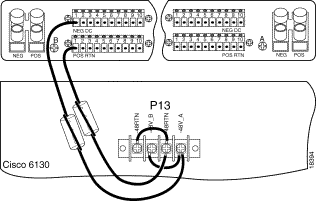
If you need to prepare the rack to accommodate the fan tray and install the thermal guard, you will need to disconnect the Champ cables from the Cisco 6100 (connectors J39 through J44) to the Cisco 6120 (connectors J1 through J6). Table 6 shows the corresponding Cisco 6100 and Cisco 6120 connectors.
| Cisco 6100 Connector | Cisco 6120 Connector |
|---|---|
J39 | J3 |
J40 | J1 |
J41 | J5 |
J42 | J4 |
J43 | J2 |
J44 | J6 |
To disconnect the Cisco 6100 chassis ground connection, complete the following steps:
 |
Note If you do not have 12 AWG wire installed, you will replace these wires with a larger gauge wire later in the procedures. |
Step 2 Unhook the end of the copper wire that is around the screw on the rack.
Step 3 Loosen the compression screw provided on the grounding lug of the Cisco 6100.
Step 4 Remove the other end of the wire.
Step 5 Tighten the compression screw.
If you need to prepare the rack to accommodate the fan tray and install the thermal guard, you will need to stabilize the rack for the new hardware components.
Verify that your Cisco 6100 Series system is installed from the bottom to the top of the rack so that the rack remains stable. If your system is not installed from the bottom to the top of the rack, make the necessary adjustments to the rack as discussed in the "Move Cisco 6100 Series System Hardware Components" section.
 |
Warning To prevent bodily injury when mounting or servicing this unit in a rack, you must take special precautions to ensure that the system remains stable. The following guidelines are provided to ensure your safety: - This unit should be mounted at the bottom of the rack if it is the only unit in the rack. - When mounting this unit in a partially filled rack, load the rack from the bottom to the top with the heaviest component at the bottom of the rack. - If the rack is provided with stabilizing devices, install the stabilizers before mounting or servicing the unit in the rack. |
If you need to prepare the rack to accommodate the fan tray and install the thermal guard, you will need to complete the following steps to move the Cisco 6100 chassis or the POTS splitter:
 |
Warning Two people are required to lift the chassis. Grasp the chassis underneath the lower edge and lift with both hands. To prevent injury, keep your back straight and lift with your legs, not your back. |
Step 2 Use a Phillips-head screwdriver to remove the mounting screws that bolt the Cisco 6100 chassis in the rack.
 |
Note Remove each Cisco 6100 chassis from the rack if you have a side-by-side rack configuration. The Cisco 6100 needs to be removed from the rack to install the thermal guard. |
Step 3 Use a Phillips-head screwdriver to remove the mounting screws that bolt the POTS splitter in the rack.
 |
Note If you are migrating from dual-port to quad-port ATU-C modules, refer to the Cisco 6100 with NI-1 Direct Connect Installation Guide for conversion procedures. Different cables and an additional POTS splitter will be needed. |
To install the fan tray in the rack, complete the following steps:
 |
Note If you are using more than one Cisco 6100 chassis in a Direct Connect with a POTS splitter configuration, you must install a fan tray under each chassis. |
Step 2 Locate the first fan and unscrew the thumbscrew that holds the fan in place (the screw at the top of each fan), as shown in Figure 4.

Step 3 Carefully remove the fan by pulling it toward you. The fan is located on slide rails for easy removal and installation. (See Figure 5.)
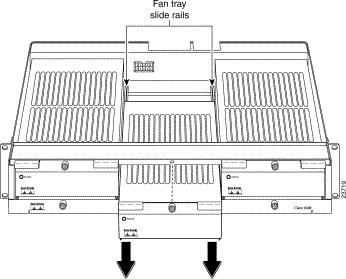
Step 4 Place the fan on a flat and stable surface (for example, a table top) until you are ready to reinsert it into the fan tray.
Step 5 Repeat Steps 2 through 4 for each fan.
Step 6 Position the fan tray chassis, which occupies 2 RUs of space, above the POTS splitter.
Allow an additional 1 RU of space between the fan tray and the POTS splitter. This space allows for the intake plenum and for cabling back to front for the OC-3c network interface module.
Step 7 Use four mounting screws and a Phillips-head screwdriver to bolt the fan tray in the rack above the POTS splitter. See Figure 1 for the correct placement of the fan tray.
Step 8 Align a fan with the fan tray slide rails inside the fan tray.
Step 9 Slide the fan into the fan tray.
Step 10 Tighten the thumbscrew above the fan.
Step 11 Repeat Steps 8 through 10 for each fan.
 |
Note For information about fan and air filter replacement, refer to the Cisco 6100 Series System Fan Tray Configuration Notes. |
A thermal guard is required when using the Cisco 6100 chassis with dual-port DMT-2 ATU-C or quad-port flexi ATU-C modules.
The thermal guard is either installed with the Cisco 6100 chassis in the rack or out of the rack.
 |
Warning Two people are required to lift the chassis. Grasp the chassis underneath the lower edge and lift with both hands. To prevent injury, keep your back straight and lift with your legs, not your back. |
To install the thermal guard on the Cisco 6100 chassis while it is in the rack, complete the following steps:
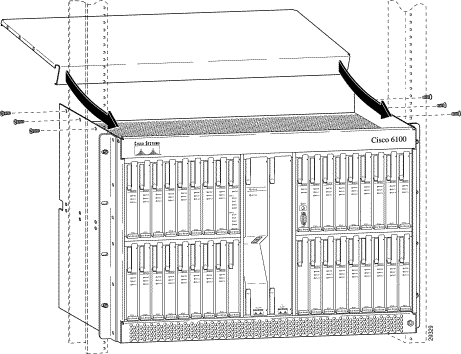
Step 2 Place the lip of the thermal guard under the lip of the Cisco 6100 chassis.
Step 3 Gently push the back of the thermal guard onto the chassis.
Step 4 Use six screws (three on each side of the chassis) to secure the thermal guard to the chassis, as shown in Figure 6.
 |
Note If you are installing the thermal guard while the chassis is in the rack, you might not be able to secure the thermal guard with all six screws. If this is the case, only the rear screw on each side is required to secure the thermal guard. |
Figure 7 shows an installed thermal guard.
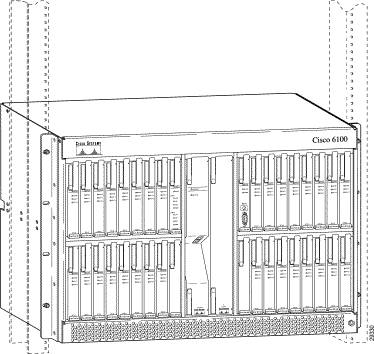
To install the thermal guard on the Cisco 6100 chassis while it is out of the rack, complete the following steps:
Step 2 Angle the thermal guard above the chassis, as shown in Figure 8.
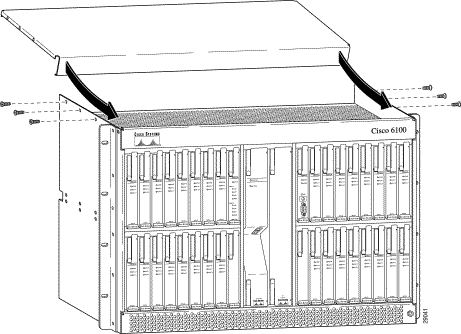
Step 3 Place the lip of the thermal guard under the lip of the Cisco 6100 chassis.
Step 4 Gently push the back of the thermal guard onto the chassis.
Step 5 Use six screws (three on each side of the chassis) to secure the thermal guard to the chassis, as shown in Figure 8.
Figure 9 shows an installed thermal guard.

You must install filler faceplates in all open slots of each chassis. The filler faceplate installation is similar to the module installation.
To install the filler faceplates in the Cisco 6100 or Cisco 6120, complete the following steps:
Step 2 Vertically align the filler faceplate edge with the module guides at the top and bottom of the slot.
Step 3 Lift up on the ejector tab and gently apply pressure to the bottom of the faceplate while pushing the filler faceplate into the slot.
Step 4 Push on the faceplate to fully seat the module.
Step 5 Press down on the ejector tab to secure the faceplate.
Complete the following steps to connect the grounding lug on the Cisco 6100 chassis directly to the rack:
 |
Caution Do not reuse the wire you removed in the "Disconnect the Cisco 6100 Chassis Ground" section, unless it is 12 AWG or larger. |
Step 2 Measure enough wire (12 AWG or thicker green or green with yellow stripes stranded copper wire) to connect the Cisco 6100 to the rack. (See Figure 10 for grounding wire location.)
 |
Note Make sure your wire is as short as possible to make the connection. |
Step 3 Use a wire stripper to remove the casing from both ends of the wires.
Step 4 Use a 3/16-inch flat-head screwdriver to loosen the screw on the rack.
Step 5 Hook one end of the copper wire around the screw on the rack.
Step 6 Tighten the rack screw over the copper wire.
Step 7 Loosen the compression screw provided on the grounding lug of the Cisco 6100.
The grounding lugs are located in the upper left corner of each chassis (viewed from the rear).
Step 8 Insert the other end of the copper wire under the compression screw.
Step 9 Tighten the compression screw over the copper wire.
 |
Note Do not ground the components in a rack by chaining them together. |
The left side of Figure 10 shows how to ground the Cisco 6100 chassis.
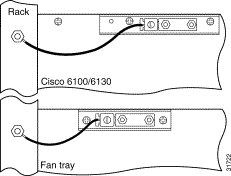
Complete the following steps to connect the grounding lug on the fan tray directly to the rack:
Step 2 Measure enough wire (14 AWG or thicker green or green with yellow stripes stranded copper wire) to connect the fan tray to the rack. (See Figure 10 for grounding wire location.)
 |
Note Make sure your wire is as short as possible to make the connection. |
Step 3 Use a wire stripper to remove the casing from both ends of the wires.
Step 4 Use a 3/16-inch flat-head screwdriver to loosen the screw on the rack.
Step 5 Hook one end of the copper wire around the screw on the rack.
Step 6 Tighten the rack screw over the copper wire.
Step 7 Loosen the compression screw provided on the grounding lug of the fan tray.
The grounding lug is located in the upper left corner of each chassis (viewed from the rear).
Step 8 Insert the other end of the copper wire under the compression screw.
Step 9 Tighten the compression screw over the copper wire.
 |
Note Do not ground the components in a rack by chaining them together. |
If you disconnected the Cisco 6100 from the Cisco 6120 in the "Disconnect the Cisco 6100 from the Cisco 6120" section, connect the Champ cables from the Cisco 6100 (connectors J39 through J44) to the Cisco 6120 (connectors J1 through J6). Table 7 shows the corresponding Cisco 6100 and Cisco 6120 connectors.
| Cisco 6100 Connector | Cisco 6120 Connector |
|---|---|
J39 | J3 |
J40 | J1 |
J41 | J5 |
J42 | J4 |
J43 | J2 |
J44 | J6 |
 |
Note If you are migrating from dual-port to quad-port ATU-C modules, refer to the Cisco 6100 with NI-1 Direct Connect Installation Guide for conversion procedures. Different cables and an additional POTS splitter will be needed. |
 |
Caution To prevent the system from powering up, do not install the fuses at this time. If the fuses are already installed in the fuse and alarm panel, remove them. You can replace the fuses after the system is wired. |
You can wire the power connections from the Cisco 6100 to the fuse and alarm panel for either dual- or single-power feed.
 |
Note The clear cover was removed in the "Disconnect the Cisco 6100 Power Connections" section. |
 |
Note Connect each Cisco 6100 Series system component to a separate fuse. Do not power the components in the rack by chaining them together. |
Complete the following steps to attach the Cisco 6100 power connections (P13) to the fuse and alarm panel for a dual-power feed:
 |
Caution Do not reuse the wire you removed in the "Disconnect the Cisco 6100 Power Connections" section, unless it is 12 AWG or larger. |
Figure 11 shows the Cisco 6100 power input connections wired to the fuse and alarm panel.
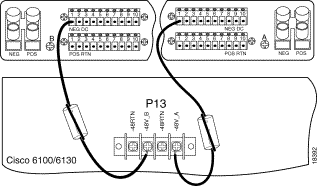
Step 2 Use a wire stripper to remove the casing from both ends of the wires.
Step 3 Use a Phillips-head screwdriver to attach a wire to the -48V_A power input connection on the Cisco 6100 (P13).
Step 4 Loop the wire through the ferrite as shown in Figure 12.

Step 5 Attach the wire to a fuse and alarm panel NEG (negative) DC connector.
Step 6 Use a Phillips-head screwdriver to attach a wire to the -48V_B power input connection on the Cisco 6100 (P13).
Step 7 Loop the wire through the ferrite as shown in Figure 12.
Step 8 Attach the wire to a fuse and alarm panel NEG DC connector.
Step 9 Measure enough wire (12 AWG black and red copper solid or stranded wire) to connect each of the Cisco 6100 power return connections to the fuse and alarm panel.
Figure 13 shows the Cisco 6100 power return connections wired to the fuse and alarm panel for a dual-power feed.

Step 10 Use a wire stripper to remove the casing from both ends of the wires.
Step 11 Use a Phillips-head screwdriver to attach a wire to a -48V power return connection (-48RTN) on the Cisco 6100 (P13).
Step 12 Loop the wire through the ferrite as shown in Figure 12.
Step 13 Attach the wire to a fuse and alarm panel POS (positive) RTN connector.
Step 14 Repeat Steps 9 through 13 for the remaining -48V power return connection (-48RTN).
Step 15 Use a socket driver or a Phillips-head screwdriver to attach the clear cover over the Cisco 6100 power connections.
Complete the following steps to attach the Cisco 6100 power connections (P13) to the fuse and alarm panel for a single-power feed:
 |
Caution Do not reuse the wire you removed in the "Disconnect the Cisco 6100 Power Connections" section, unless it is 12 AWG or larger. |
Figure 14 shows the Cisco 6100 power connections wired to the fuse and alarm panel for a single-power feed.

Step 2 Use a wire stripper to remove the casing from both ends of the wires.
Step 3 Use a Phillips-head screwdriver, to attach a wire to the -48V_A power input connection on the Cisco 6100 (P13).
Step 4 Loop the wire through the ferrite as shown in Figure 15.

Step 5 Attach the wire to the fuse and alarm panel NEG DC connector.
Step 6 Use a Phillips-head screwdriver to attach a wire to a -48RTN power return connection on the Cisco 6100 (P13). See Figure 14 for correct placement.
Step 7 Loop the wire through the ferrite as shown in Figure 15.
Step 8 Attach the wire to the fuse and alarm panel POS RTN connector. See Figure 14 for correct placement.
Step 9 Use a Phillips-head screwdriver to attach a wire to connect the -48V_A and -48V_B power input connections to each other.
Step 10 Use a Phillips-head screwdriver to attach a wire to connect the -48RTN power return connections to each other.
Step 11 Use a socket driver or a Phillips-head screwdriver to attach the clear cover over the Cisco 6100 power connections.
Power is fed from the fuse and alarm panel to the fan tray by a terminal block connector with four dual power connections (P1) located at the top of the fan tray backplane. Figure 16 shows the location of the power connection (P1) on the fan tray.
 |
Note The fuse and alarm panel and wires are not provided by Cisco Systems, Inc. |

 |
Note Connect each Cisco 6100 Series system component to a separate fuse. Do not power the components in the rack by chaining the power connections to each other. |
You can wire the power connections from the fuse and alarm panel to the fan tray for either dual- or single-power feed.
To attach the fan tray power connections to the fuse and alarm panel for a dual-power feed, complete the following steps:
Step 2 Measure enough wire (14 to 18 AWG copper solid or stranded wire) to connect each of the fan tray power connections to the fuse and alarm panel.
Figure 17 shows the power connections from the fan tray to the fuse and alarm panel for a dual-power feed.

Step 3 Use a wire stripper to remove the casing from both ends of the wires.
Step 4 Use a Phillips-head screwdriver to attach a wire to the -48VA power input connection on the fan tray (P1).
Step 5 Attach the wire to the fuse and alarm panel NEG DC connector. See Figure 17 for correct placement.
Step 6 Use a Phillips-head screwdriver to attach a wire to the -48VB power input connection on the fan tray (P1).
Step 7 Attach the wire to the fuse and alarm panel NEG DC connector. See Figure 17 for correct placement.
Step 8 Use a Phillips-head screwdriver to attach a wire to a -48RTN power return connection on the fan tray (P13).
Step 9 Attach the wire to a fuse and alarm panel POS RTN connector.
Step 10 Repeat Steps 8 and 9 for the remaining -48RTN power return connection.
Step 11 Use a socket driver or a Phillips-head screwdriver to attach the clear cover over the fan tray power connections.
Complete the following steps to attach the fan tray power connections to the fuse and alarm panel for a single-power feed:
Step 2 Measure enough wire (14 to 18 AWG copper solid or stranded wire) to connect each of the fan tray power connections to the fuse and alarm panel.
Figure 18 shows the power connections from the fan tray to the fuse and alarm panel for a single-power feed.
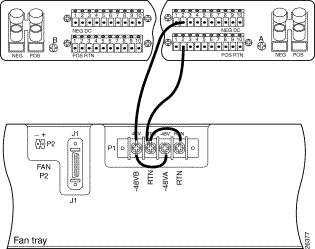
Step 3 Use a wire stripper to remove the casing from both ends of the wires.
Step 4 Use a Phillips-head screwdriver to attach a wire to the -48VA power input connection on the fan tray (P1).
Step 5 Attach the wire to the fuse and alarm panel NEG DC connector.
Step 6 Use a Phillips-head screwdriver to attach a wire to an RTN power return connection on the fan tray (P1). See Figure 18 for correct placement.
Step 7 Attach the wire to the fuse and alarm panel POS RTN connector. See Figure 18 for correct placement.
Step 8 Use a Phillips-head screwdriver to attach a wire to connect the -48VA and -48VB power input connections to each other.
Step 9 Use a Phillips-head screwdriver to attach a wire to connect the RTN power return connections to each other.
Step 10 Use a socket driver or a Phillips-head screwdriver to attach the clear cover over the fan tray power connections.
You must connect the fan tray alarm contacts so that the fan tray alarms can be transmitted to the ViewRunner management software.
 |
Caution If fuses are already installed in the fuse and alarm panel, remove them. You can replace the fuses after the system is installed. Do not power up the system while you install and connect the system. |
To connect the fan tray alarm contacts, complete the following steps:
Figure 19 shows how the fan tray two-position header (P2) connects to the fan tray alarm contacts (P14, pins 7 and 8) on the Cisco 6100 backplane.

See Figure 20 for a close view of the alarm contact pinouts. For pinout descriptions, see the Cisco 6100 with NI-1 Direct Connect Installation Guide.
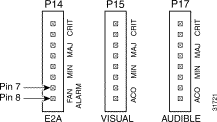
Step 2 Use a wire stripper to remove the casing from both ends of the wires.
Step 3 Wire P2 on the backplane of the fan tray to P14 (pin 7) on the backplane of the Cisco 6100 to connect the Fan Alarm+ contact. Use a wire wrapping tool to attach the wire to the contacts.
Step 4 Wire P2 on the backplane of the fan tray to P15 (pin 8) on the backplane of the Cisco 6100 to connect the Fan Alarm- contact. Use a wire wrapping tool to attach the wire to the contacts.
Complete the following steps to pull the modules away from the chassis backplane connection:
 |
Caution If the modules are installed when you apply power to the system, you could damage the modules and the chassis. |
Step 2 Lift up the ejector tab. This action disconnects the module from the backplane.
Step 3 Carefully slide the module forward and away from the backplane connection.
Step 4 Repeat Step 2 through Step 3 for each module in the Cisco 6100 chassis and each POTS module in the Cisco 6120 chassis.
Verify that all of the DIP switches are set on SW1 and SW2 to the OFF position (Figure 21).
 |
Warning Systems using a Cisco 6100 chassis must connect to the network through a POTS splitter to provide the secondary lightning protection required by NEBS. |

If you disconnected the subtended network configuration in the "Disconnect the Subtended Network Configuration" section, complete the steps in the following sections to reconnect the subtended network configuration:

Step 2 Verify that ferrites are added to the coaxial cables that you use to cable the DS3 subtending I/O card to the system I/O card to reduce the radiation/EMI susceptibility to high frequency noise between 30 and 200 MHz. If the ferrites are not present, use either the ferrites that were shipped with the DS3 network interface module or ferrites that yield an impedance greater than 200 ohms +/- 20 percent at 100 MHz.
If you are using

 |
Note The minimum bend radius for thin type 735A coaxial cable or equivalent is one-quarter of an inch. If the minimum bend radius exceeds one-quarter of an inch, the cable might not work properly. |
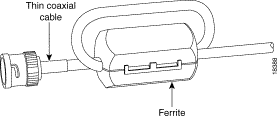
Step 3 Attach a ferrite as close as possible to the remaining end of the cable (see Figure 23 or Figure 24 for ferrite installation). Tie wrap the cable directly behind the ferrite.
Step 4 Attach the end of the cable used in Step 3 to the receive DS3 BNC connector (RX) for the system I/O card on the subtended node chassis backplane.
Step 5 Attach one end of a coaxial cable to the receive DS3 BNC connector (RX1) for the DS3 subtending I/O card on the subtending host chassis backplane.
Step 6 Attach the ferrite as close as possible to the receive DS3 BNC connector (RX1) on the DS3 subtending I/O card (see Figure 23 or Figure 24 for ferrite installation). Tie wrap the cable directly behind the ferrite.
Step 7 Attach a ferrite as close as possible to the remaining end of the cable (see Figure 23 or Figure 24 for ferrite installation). Tie wrap the cable directly behind the ferrite.
Step 8 Attach the end of the cable used in Step 7 to the transmit DS3 BNC connector (TX) for the system I/O card on the subtended node chassis backplane.
Step 9 Tie wrap the transmit and receive cables coming from the DS3 subtending I/O card where the cables meet after coming from the ferrites and every 1 foot thereafter for a total of 15 feet, as shown in Figure 25.

Step 10 Tie wrap the transmit and receive cables coming from the system I/O card where the cables meet after coming from the ferrites and every 1 foot thereafter for a total of 15 feet, as shown in Figure 26.
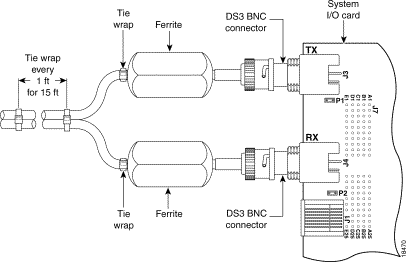
 |
Note If you have one subtending host chassis with two subtended node chassis, the second subtended node chassis connects to the TX2 and RX2 DS3 BNC connectors on the DS3 subtending I/O card. |
Step 11 Install the plastic ESD shield over the DS3 subtending I/O card using the following steps:
a. Position the holes in the plastic ESD shield over the existing standoff screws installed on the DS3 subtending I/O card.
b. Use a Phillips-head screwdriver and the backplane screws you removed in the "Disconnect the Subtended Network Configuration" section to attach the plastic ESD shield to the DS3 subtending I/O card (see Figure 27).
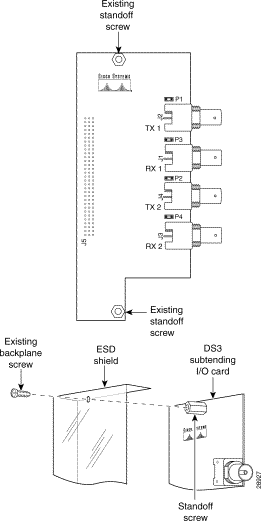
Step 12 Repeat Steps 1 through 11 for each subtending host chassis to subtended node chassis connection.
To apply power to the Cisco 6100 Series system, complete the following steps:
Step 2 Apply power to the system with one of the following methods:
 |
Note You will need to upgrade to 15A fuses. |
 |
Caution If the modules are installed when you apply power to the system, you could damage the modules and the chassis. |
Step 3 Verify that the power connections from the Cisco 6100 to the fuse and alarm panel are wired as shown in Figure 11 or Figure 14.
Step 4 Verify that the power connections from the fan tray to the fuse and alarm panel are wired as shown in Figure 17 or Figure 18.
Step 5 Check the polarity of the -48 VDC connections to each chassis by attaching a voltmeter with the minus lead on -48RTN and the plus lead on -48V_A. Ensure that the meter reads between -36 VDC and -60 VDC. If your voltmeter shows a positive voltage, the power inputs might be reversed. If the voltmeter shows a negative voltage that is out of the -36 VDC to -60 VDC range, check the power supply for failure or check for a blown fuse in the fuse and alarm panel.
Verify that the fans are operational by locating the LED on the front of each fan. If the LED is
The fans should be operational before you install the modules.
 |
Caution It is important that the Cisco 6100 cooling fans run continuously. |
 |
Warning The power supply circuitry for the Cisco DSLAM equipment can constitute an energy hazard. Before you install or replace the equipment, remove all jewelry (including rings, necklaces, and watches). Metal objects can come into contact with exposed power supply wiring or circuitry inside the DSLAM equipment. This could cause the metal objects to heat up and cause serious burns or weld the metal object to the equipment. |
 |
Warning Do not reach into a vacant slot or chassis while you install or remove a module or a fan. Exposed circuitry could constitute an energy hazard. |
 |
Caution Proper ESD protection is required each time you handle Cisco DSLAM equipment. Installation and maintenance personnel should be properly grounded using ground straps to eliminate the risk of ESD damage to the equipment. Modules are subject to ESD damage each time they are removed from the chassis. |
To reseat all of the modules, complete the following steps. It is important that you accomplish each step completely before moving on to the next step.
 |
Note All modules must be fully seated in the chassis. A push on the faceplate of each module is required for the module to be fully seated. |
a. Lift up on the ejector tab and gently apply pressure to the bottom of the faceplate while pushing the module into the slot.
b. Push on the faceplate of each module to fully seat the module.
c. Press down on the ejector tab to secure the module and connect it to the backplane.
d. Reseat the remaining xTU-C modules using the same procedure.
Step 2 Reseat the network interface module in the Cisco 6100.
a. Lift up on the ejector tabs and gently apply pressure to the bottom of the faceplate while pushing the module into the slot.
b. Push on the faceplate of each module to fully seat the module.
c. Press down on the ejector tabs to secure the module and connect it to the backplane.
Step 3 Reseat the POTS modules in the Cisco 6120.
a. Lift up on the ejector tab and gently apply pressure to the bottom of the faceplate while pushing the module into the slot.
b. Push on the faceplate of each module to fully seat the module.
c. Press down on the ejector tab to secure the module and connect it to the backplane.
d. Reseat the remaining POTS modules using the same procedure.
Step 4 Reseat the DS3 subtend host module (STM) in the Cisco 6100 (if applicable).
a. Lift up on the ejector tab and gently apply pressure to the bottom of the faceplate while pushing the module into the slot.
b. Push on the faceplate of each module to fully seat the module.
c. Press down on the ejector tab to secure the module and connect it to the backplane.
Step 5 Reseat the system controller module in the Cisco 6100.
a. Lift up on the ejector tab and gently apply pressure to the bottom of the faceplate while pushing the module into the slot.
b. Push on the faceplate of each module to fully seat the module.
c. Press down on the ejector tab to secure the module and connect it to the backplane. This causes each module in the Cisco 6100 to reset.
Step 6 Verify that the STATUS LEDs on all modules are solid green (where applicable).
This self-test procedure takes several minutes. Verify that there are no alarms on the system controller module (ALARM LED off). If the STATUS LEDs are not green after the self-test, refer to the Cisco 6100 with NI-1 Direct Connect Installation Guide for troubleshooting procedures.
Step 7 Perform a software update using the ViewRunner software if the STATUS LEDs on the xTU-C modules or the network interface module are flashing.
Refer to the ViewRunner for Windows Direct Connect Provisioning Guide or the ViewRunner for HP OpenView Direct Connect Provisioning Guide for software upgrade procedures.
If you disconnected the network interface module in the "Disconnect the Network Interface Modules" section, complete the steps in the following sections to reconnect the subtended network configuration.
Complete the following steps to connect the network interface modules:
a. Take one cable that was removed in the "Disconnect the Subtended Network Configuration" section coming from the ATM switch to the receive (J4) DS3 BNC connector on the system I/O card on the Cisco 6100 backplane.
b. Take one cable that was removed in the "Disconnect the Subtended Network Configuration" section coming from the ATM switch to the transmit (J3) DS3 BNC connector on the system I/O card on the Cisco 6100 backplane.
Step 2 Connect the optical fiber to the transmit and receive connectors in the inset on the front panel of the OC-3c network interface module if you have an OC-3c network interface module installed in slot 10 of the Cisco 6100.
a. Connect the OC-3c network interface module transmit and receive cables from the ATM switch through the 1 RU of space between the fan tray and the POTS splitter.
b. Attach the optical fiber to the transmit and receive connectors in the inset on the front panel of the OC-3c network interface modules.
c. Allow enough slack in the cable so that the fan tray can be opened and the fans can be maintained.
d. Coil the fiber loosely within the 1 RU of space to take out slack.
Complete the following steps to attach the Cisco 6100 chassis ventilation cover:
Step 2 Attach the ventilation cover over the open vents on the bottom of the chassis, as shown in Figure 28.
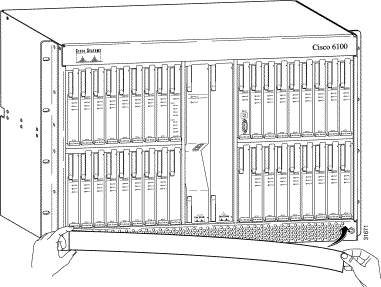
Complete the following steps to attach the new power rating label:
Step 2 Peel the backing off the new power rating label.
Step 3 Attach the new power rating label directly over the current power rating on your chassis, as shown in Figure 29.
Ensure that the 'C' on the current power rating is not covered by the new label.
 |
Note If you cannot locate your current power rating label, please attach the new power rating label to the backplane plastic cover. |
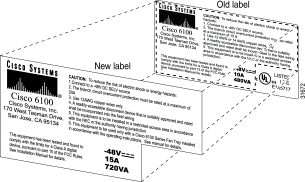
Verify that the Cisco 6100 front door is attached to the chassis and closed (see Figure 30).
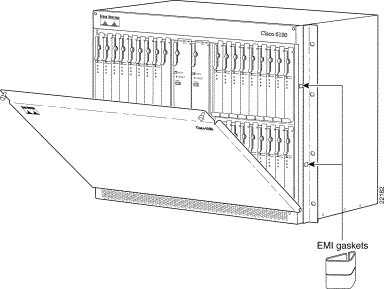
If you disconnected the ViewRunner system in the "Disconnect ViewRunner" section, complete the steps in the following sections to reconnect the ViewRunner system:
Step 2 Connect the other end of the Ethernet cable to one of the following:
 |
Note If you are connecting the Ethernet cable to a PC, you need a crossover cable. |
Step 3 Install the plastic ESD shield over the system I/O card using the following steps:
a. Position the holes in the plastic ESD shield over the existing standoff screws installed on the system I/O card.
b. Use a Phillips-head screwdriver and the backplane screws you removed in the "Disconnect the Network Interface Modules" section to attach the plastic ESD shield to the system I/O card (see Figure 31).

 |
Tip For step-by-step instructions on provisioning a Direct Connect configuration, refer to the ViewRunner for Windows Direct Connect Provisioning Guide or the ViewRunner for HP OpenView Direct Connect Provisioning Guide. |
Complete the following steps to close the optional rear door:
Step 2 Lift the two latches on the rear door (as shown in Figure 32) as you close the rear door. The rear door closes left to right (seen from the rear of the chassis).

Step 3 Release the latches after the rear door is in place.
Step 4 Align the two thumbscrews located on the rear door with two thumbscrew fasteners on the bracket (see Figure 33). Tighten the thumbscrews to secure the rear door.
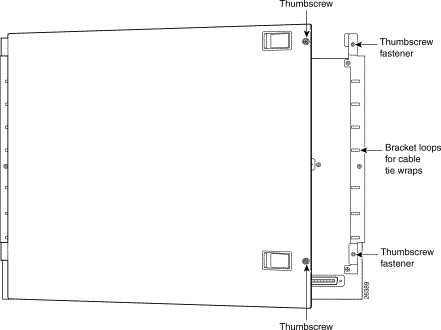
To verify that the system is connected and running properly, follow the connection test procedures in the Cisco 6100 with NI-1 Direct Connect Installation Guide.
The following sections list the CO and customer premises equipment (CPE) publications that relate to the Cisco DSL product family.
A complete list of all released Cisco 6100 Series systems with NI-1 related documentation is available on the World Wide Web at http://www.cisco.com/univercd/cc/td/doc/product/dsl_prod/c6100/index.htm.
The following ViewRunner management software is used to provision and manage the Cisco 6100 Series system with NI-1. A complete list of all released ViewRunner documentation is available on the Word Wide Web.
The Cisco CPE, also known as the Cisco 600 Series, is part of the Cisco end-to-end DSL product family. CPE comprises modems and routers at the customer site primarily used by home office and corporate LAN personnel. Most CPE uses the Cisco Broadband Operating System (CBOS) as its operating system. CBOS provides a comprehensive command set and web interface that allow you to configure your Cisco CPE modem or router.
A complete list of all released Cisco 600 Series documentation is available on the World Wide Web at http://www.cisco.com/univercd/cc/td/doc/product/dsl_prod/c600s/index.htm.
Cisco Connection Online (CCO) is Cisco Systems' primary, real-time support channel. Maintenance customers and partners can self-register on CCO to obtain additional information and services.
Available 24 hours a day, 7 days a week, CCO provides a wealth of standard and value-added services to Cisco's customers and business partners. CCO services include product information, product documentation, software updates, release notes, technical tips, the Bug Navigator, configuration notes, brochures, descriptions of service offerings, and download access to public and authorized files.
CCO serves a wide variety of users through two interfaces that are updated and enhanced simultaneously: a character-based version and a multimedia version that resides on the World Wide Web (WWW). The character-based CCO supports Zmodem, Kermit, Xmodem, FTP, and Internet e-mail, and it is excellent for quick access to information over lower bandwidths. The WWW version of CCO provides richly formatted documents with photographs, figures, graphics, and video, as well as hyperlinks to related information.
You can access CCO in the following ways:
For a copy of CCO's Frequently Asked Questions (FAQ), contact cco-help@cisco.com. For additional information, contact cco-team@cisco.com.
 |
Note If you are a network administrator and need personal technical assistance with a Cisco product that is under warranty or covered by a maintenance contract, contact Cisco's Technical Assistance Center (TAC) at 800 553-2447, 408 526-7209, or tac@cisco.com. To obtain general information about Cisco Systems, Cisco products, or upgrades, contact 800 553-6387, 408 526-7208, or cs-rep@cisco.com. |
Cisco documentation and additional literature are available in a CD-ROM package, which ships with your product. The Documentation CD-ROM, a member of the Cisco Connection Family, is updated monthly. Therefore, it might be more current than printed documentation. To order additional copies of the Documentation CD-ROM, contact your local sales representative or call customer service. The CD-ROM package is available as a single package or as an annual subscription. You can also access Cisco documentation on the World Wide Web at http://www.cisco.com, http://www-china.cisco.com, or http://www-europe.cisco.com.
If you are reading Cisco product documentation on the World Wide Web, you can submit comments electronically. Click Feedback in the toolbar and select Documentation. After you complete the form, click Submit to send it to Cisco. We appreciate your comments.
This document is to be used in conjunction with the documents listed in the "Related Documentation" section.
Access Registrar, AccessPath, Any to Any, AtmDirector, Browse with Me, CCDA, CCDE, CCDP, CCIE, CCNA, CCNP, CCSI, CD-PAC, the Cisco logo, Cisco Certified Internetwork Expert logo, CiscoLink, the Cisco Management Connection logo, the Cisco NetWorks logo, the Cisco Powered Network logo, Cisco Systems Capital, the Cisco Systems Capital logo, Cisco Systems Networking Academy, the Cisco Systems Networking Academy logo, the Cisco Technologies logo, ConnectWay, Fast Step, FireRunner, Follow Me Browsing, FormShare, GigaStack, IGX, Intelligence in the Optical Core, Internet Quotient, IP/VC, Kernel Proxy, MGX, MultiPath Data, MultiPath Voice, Natural Network Viewer, NetSonar, Network Registrar, the Networkers logo, Packet, PIX, Point and Click Internetworking, Policy Builder, Precept, ScriptShare, Secure Script, ServiceWay, Shop with Me, SlideCast, SMARTnet, SVX, The Cell, TrafficDirector, TransPath, ViewRunner, Virtual Loop Carrier System, Virtual Service Node, Virtual Voice Line, VisionWay, VlanDirector, Voice LAN, WaRP, Wavelength Router, Wavelength Router Protocol, WebViewer, Workgroup Director, and Workgroup Stack are trademarks; Changing the Way We Work, Live, Play, and Learn, Empowering the Internet Generation, The Internet Economy, and The New Internet Economy are service marks; and ASIST, BPX, Catalyst, Cisco, Cisco IOS, the Cisco IOS logo, Cisco Systems, the Cisco Systems logo, the Cisco Systems Cisco Press logo, Enterprise/Solver, EtherChannel, EtherSwitch, FastHub, FastLink, FastPAD, FastSwitch, GeoTel, IOS, IP/TV, IPX, LightStream, LightSwitch, MICA, NetRanger, Post-Routing, Pre-Routing, Registrar, StrataView Plus, Stratm, TeleRouter, and VCO are registered trademarks of Cisco Systems, Inc. or its affiliates in the U.S. and certain other countries. All other trademarks mentioned in this document are the property of their respective owners. The use of the word partner does not imply a partnership relationship between Cisco and any of its resellers. (9912R)
Copyright © 2000, Cisco Systems, Inc.
All rights reserved.
![]()
![]()
![]()
![]()
![]()
![]()
![]()
![]()
Posted: Thu Jul 25 00:44:47 PDT 2002
All contents are Copyright © 1992--2002 Cisco Systems, Inc. All rights reserved.
Important Notices and Privacy Statement.